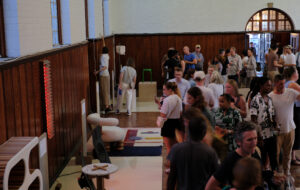|
Friedrichstrasse skyscraper, Mies van der Rohe, 1922 (image: Bauhaus-Archiv Berlin © VG Bild-Kunst, Bonn 2009) |
||
|
This monster show celebrating the 90th birthday of the seminal modernist institution does a fine job of identifying its importance and probing its legacy, says Daniel Miller. Founded in 1919, the Bauhaus is celebrating its 90th birthday this summer with a massive retrospective at the Martin-Gropius-Bau in Berlin, later set to travel to New York. With around 900 objects, including puppets, paintings, collages, furniture, posters, journals, sketches, teapots, chess sets and postcards, the show strikingly demonstrates the cardinal place of the Bauhaus within modernism. It was at once a school, a laboratory, a business, a branding operation and (to some extent) a machine-cult. Pragmatic and concessionary – Mies designed the 1926 Berlin memorial for the murdered Spartacist leaders Rosa Luxemburg and Karl Liebknecht, but later wasn’t above pitching plans to the Nazis, including sketches complete with swastikas – the institution employed artists as diverse as the mystical Kandinsky and the individualist Paul Klee, while absorbing influences as diverse as dada, constructivism and de stijl. The program emphasised democratic equality, rather than revolutionary zeal: what Walter Gropius later defined in his book The Scope of Total Architecture (1956) as “the common citizenship of all forms of creative work and their logical interdependence on one another in the modern world”. In archival footage reproduced in the show, Gropius speaks of his desire to create work that would be representative of its age, and also to serve the needs of people, rather than the needs of luxury. The aesthetic commitment was to rationalism and clarity, while the practical one was to affordability and access. Both assignments had costs. Anticipating subsequent capitalist absorptions, the Bauhaus planed down the edges of the strategies it amalgamated; practices like dada could be recycled as styles, but its political radicalism had to be excised, in the cause of establishing unifying design coherence. Later the emphasis on expanding access would degenerate into banal standardisation. In the United States, Mies’ Mallarméan “degree-zero” proved surprisingly attractive as models to imitate, and surprisingly difficult as architecture to execute, and clunky glass boxes came to command the skylines of American cities. Meanwhile in Europe, IKEA would rise to pre-eminence as a much more ambivalent champion of democratic design. Modell Bauhaus is sensitive to these questions of legacy. The central atrium of the Martin-Gropius-Bau (a building designed by Walter’s uncle) hosts Ilka and Andreas Ruby’s throughtful video-installation Endless Bauhaus (2009), a collage of interviews with 11 prominent architects and designers, edited to resemble a discusion. Michael Rock of the New York studio 2×4 provides three of the most stimulating comments, claiming that branding has replaced ideology and that the turn towards the local in contemporary design practice is a result of the catastrophic modernist failure at solving the big problems. Nevertheless the contemporary retreat harbours its own deadlock. Designers today, Rock points out, have learned to operate with a belief in progress, but if there is no hope of improving things, then the result is that everything is just being eternally altered, to no end, and no point. In an age of industrialisation, the Bauhaus styled itself as the workshop of modernity. In a post-industrial age, the paradigmatic design form is the “network studio”, as exemplified by Ben van Berkel and Caroline Bos’ UN (“United Networks”) Studio and Rem Koolhaas’ OMA/AMO. For these firms the proposal is no longer democracy, but rather leveraging extensive interpersonal network of curators, philosophers, editors, and designers to offer (in the words of former AMO principal Jeffrey Inaba) corporate clients such as Prada, Conde Nast and Harvard University “cultural intelligence with a decided point of view’.’ It is hard to interpret this transition as positive.
Design for a trade fair stand for a toothpaste manufacturer Herbert Buyer, 1924 (image: Harvard University Arts Museums © VG Bild-Kunst, Bonn, 2009)
Friedrichstrasse skyscraper, Mies van der Rohe, 1922 (image: Bauhaus-Archiv Berlin © VG Bild-Kunst, Bonn 2009) Bauhaus: A Conceptual Model is at Martin-Gropius-Bau, Berlin, until 4 October |
Words Daniel Miller |
|
|
||



















